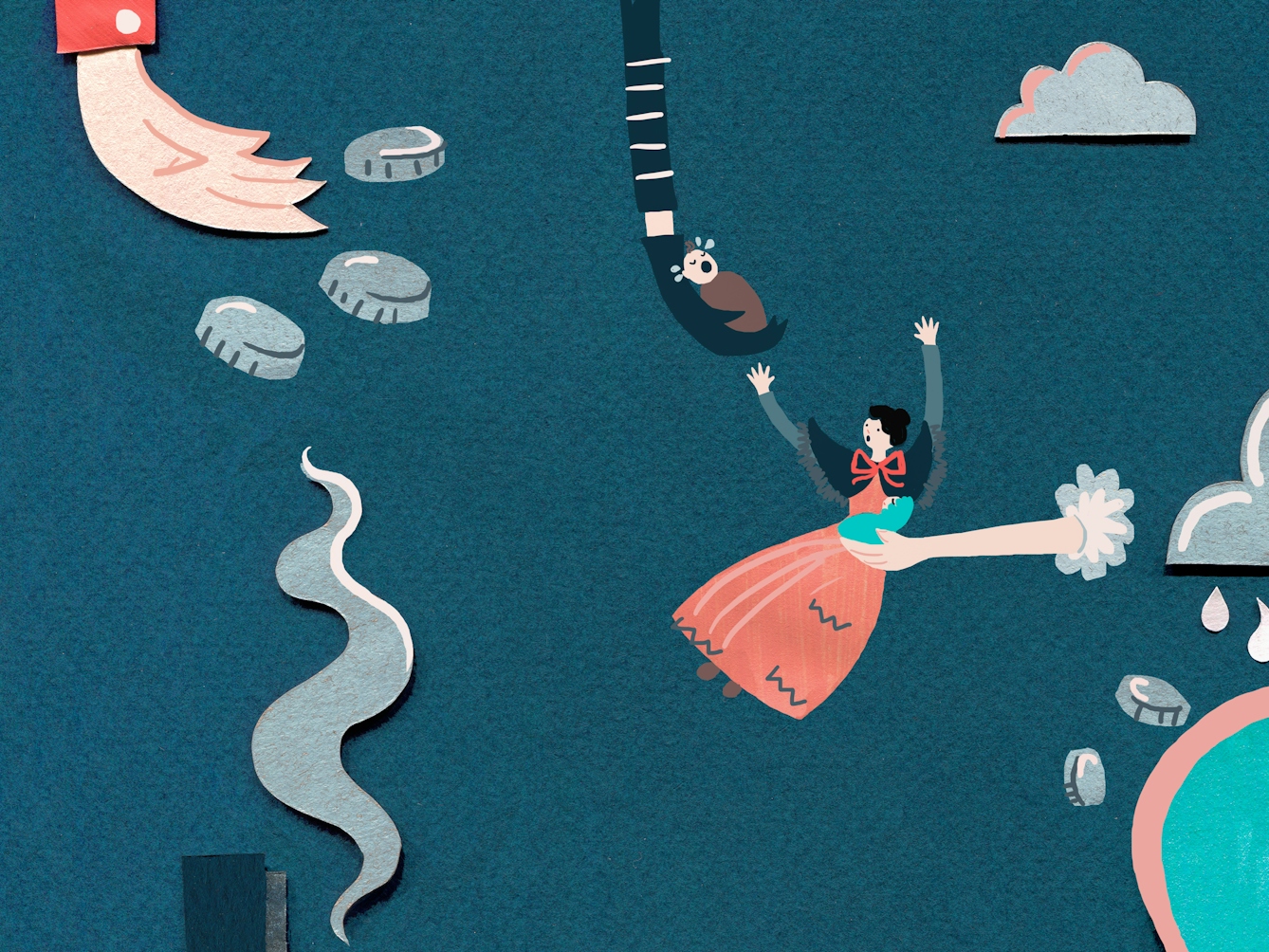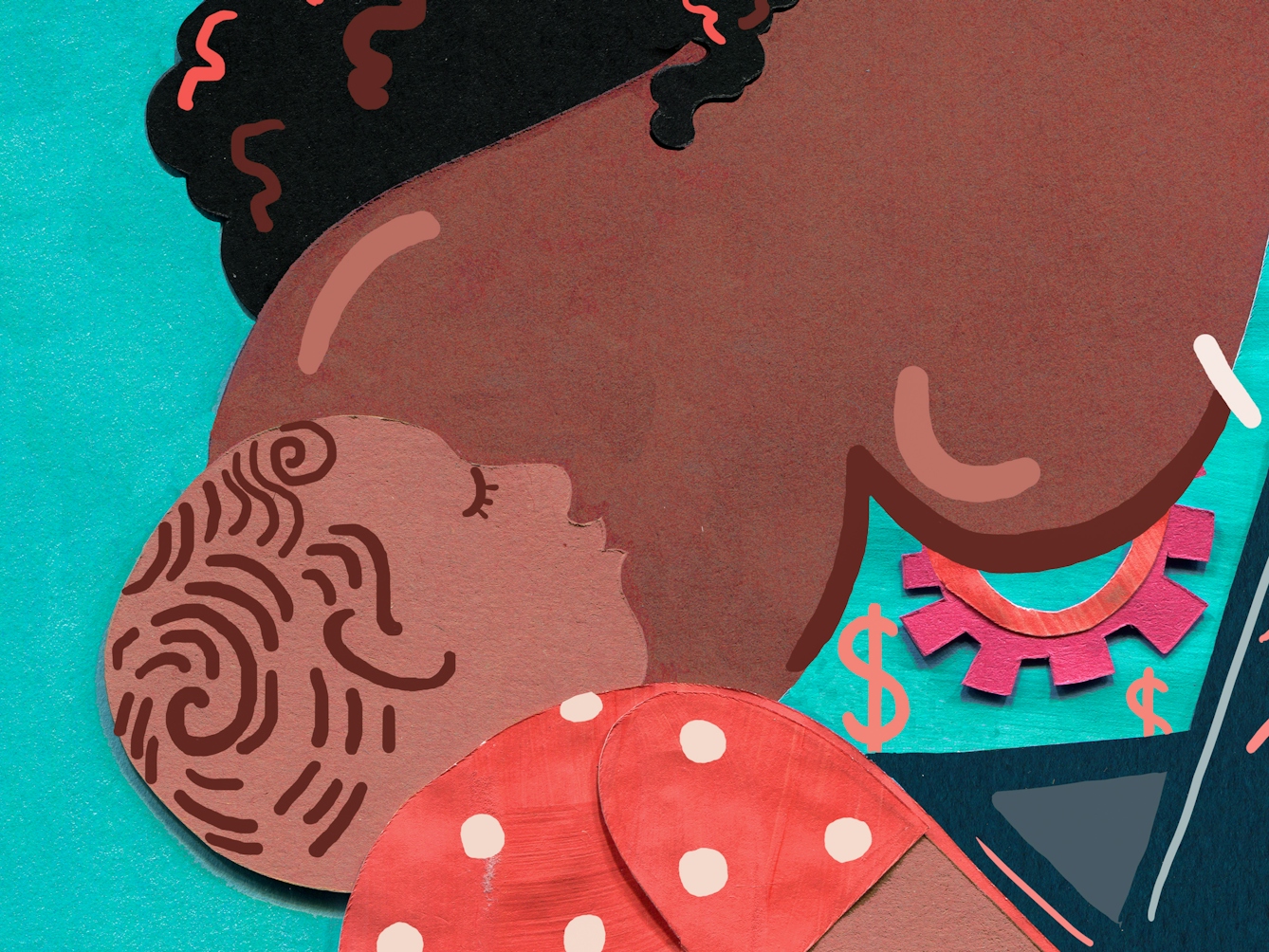Contemporary breastmilk marketplaces don’t just enable sachets of frozen milk to be exchanged for cash. It’s also possible to buy the act of breastfeeding itself, whether you’re a parent wanting to provide for your baby or an adult with a fetish. As she debates whether she’d ever breastfeed someone else’s child or let a stranger nurse her own, Alev Scott considers the history of wet-nursing and talks to two women working as wet-nurses in the US today.
The work of wet-nursing
Words by Alev Scottartwork by Vicky Scottaverage reading time 6 minutes
- Serial

For millennia, breastfeeding was essential for infant survival. If a mother could not or chose not to feed her own baby, or she died in childbirth, the task fell to another woman. In ancient times, this was often a female slave or a family member (it’s been reported that Tutankhamun’s wet-nurse might have been his sister), while professional wet-nurses, employed by choice as well as necessity, were in high demand until the late 19th century.
As a new mother in a world (almost) devoid of wet-nurses, it was difficult for me to imagine breastfeeding a stranger’s child, and even more difficult to imagine paying another woman to feed my baby. Yet wet-nursing was once, in the words of a London-based doctor in 1871, a service “resorted to from one end of the country to the other”, particularly by nobility.
Queen Victoria was horrified when both Princess Vicky and Princess Alice chose to breastfeed, and allegedly named a cow in the royal dairy after Alice. When Vicky described “the pride of giving life to an immortal soul”, her mother responded, “I think much more of our being like a cow or a dog at such moments; when our poor nature becomes so very animal and unecstatic.”
According to the 19th-century American physician Arthur Meigs, “The class of society from which wet-nurses are drawn is a very low one.” These women were often resented by the mothers who hired them, and routinely dismissed despite offering such a vital service. Their crimes included not producing enough milk and pining after their own babies, “who might have been sent off to a baby farm to be dry-nursed”.
Knowing how stress and lack of sleep affected my own milk supply, I found the struggles of wet-nurses unsurprising. How would it feel to be far from one’s own baby in a strange and often hostile environment? How easy would it be, physiologically, to lactate for another woman’s baby? Would the all-important “love hormone”, oxytocin, readily flow?
The modern wet-nursing market
There’s a small but active commercial wet-nursing section on the online breastmilk marketplace Only The Breast. One woman, Tina, based in the US, gave her newly born daughter up for adoption “due to inflation”, according to her ad. In an email to me, she explained more about her struggles to look after her family and the reasons for her decision, and how she had started wet-nursing in her teens after the birth of her first child.

“These women were often resented by the mothers who hired them, and routinely dismissed despite offering such a vital service.”
Some of Tina’s customers are men, whom she charges considerably more to wet-nurse than she does babies: “If a mom is in critical condition and can’t wet-nurse or take care of her child and wants me to do both, I charge around $2,000 monthly… [If] she just wants her kid to breastfeed every other day and buys milk, I charge 75 cents per ounce and $50 [per day] to wet-nurse…” For men, however, “it ranges from $150 to $400 [per session]”.
I tried to ask her more about breastfeeding men without seeming judgmental or voyeuristic – does she feel safe? “When I have men, I keep my gun in my pocket next to me. But I never have to use it because [before wet-nursing them] I meet them at a public place.”
She went on to describe the vetting process. “First we chat, and I see if I’m interested. If I’m interested, I then accept the offer, but the men have to pay before they get the address.”
Some of Tina’s customers are men, whom she charges considerably more to wet-nurse than she does babies.
Tina didn’t seem to think too closely about why men want to breastfeed, accepting the common and euphemistic line that they have “something wrong with them, and breastmilk helps it”.
While the money is relatively good, I sensed that Tina’s still uncomfortable with feeding men: “I should’ve said ‘only babies’ but I never knew men had such interest in this until I made the ad.”
Karen Pollock, the psychotherapist who spoke to me about male fetishes for breastmilk, also had some insight into the crossover between sex work and adult wet-nursing: “Some women will take hormones to lactate to wet-nurse… It’s a lucrative way of making money.”
Karen pointed out that adult wet-nursing is something of a loophole for sex workers in the US, where both the purchase and sale of sex is against the law, except in certain rural counties in Nevada. Karen explained that, in the UK, wet-nurses can advertise on AdultWork (a sex-work site) rather than Only The Breast “because it is legal, so they don't need to hide it”.
A higher price for ‘healthier’ milk
For centuries, people have believed that the physical health and diet of a wet-nurse will affect her milk, and therefore whoever imbibes it. Historically, this extended to moral and mental characteristics as well as physical – a wet-nurse was “one-quarter cow and three-quarters devil”, in the view of one American doctor, quoted in 1896.

“If a mom is in critical condition and can’t wet-nurse or take care of her child and wants me to do both, I charge around $2,000 monthly.”
More justifiably, doctors worried about the spread of diseases, including syphilis – for example, in 1887 a doctor presented case reports that noted the disease was spreading among wet-nursed babies.
Today, online sellers of breastmilk often advertise their organic, vegan or gluten-free diets, knowing this can sometimes command a higher price. Browsing ads, it seemed to me that the same applies to wet-nurses too.
Far more expensive than Tina is Beatrice. She has seven children of her own, 18 years of experience, and says she’s willing to combine babysitting and wet-nursing for $2,000 a week, offering to eliminate “anything from [her] diet that will upset the baby’s tummy”.
Beatrice told me that while she didn’t mind selling her milk to men, she would only breastfeed babies (although she was yet to find any baby customers via Only The Breast). She also claimed that “what I am honestly looking for [is] to help with this formula shortage deal that we are currently dealing with in our society”.
She wanted to help – at a price. And why not? Here, again, was the thorny question – do mothers deserve to be paid for the labour of producing milk, or should they help each other for free? Is breastmilk a commodity like any other, or is it on a different social and moral plane? If men lactated, would this subject be as ethically confused – do we expect more altruism of women than we do of men?
Instinctively, I think we do expect women to be more giving and selfless than men – especially as parents. And many do choose to share rather than sell their milk. Next, I want to examine how and why.
Some names have been changed.
About the contributors
Alev Scott
Alev Scott is a journalist and author. Previously based in Istanbul and Athens, she has written about politics and culture in the Mediterranean region for the Financial Times, the Guardian, Harper’s Magazine and Newsweek, among others. Her books are ‘Turkish Awakening’, ‘Ottoman Odyssey’ and ‘Power and the People’.
Vicky Scott
Vicky Scott is a Sheffield-based freelance illustrator who specialises in creating colourful and eye-catching mixed-media collages. Her work is inspired by Art Deco, 1960s psychedelia, mid-20th-century travel posters, and the natural world. To date, she has been commissioned to illustrate for a diverse range of clients including Microsoft, Cheltenham Festivals, the Postal Museum, Waitrose and the RSPB.

